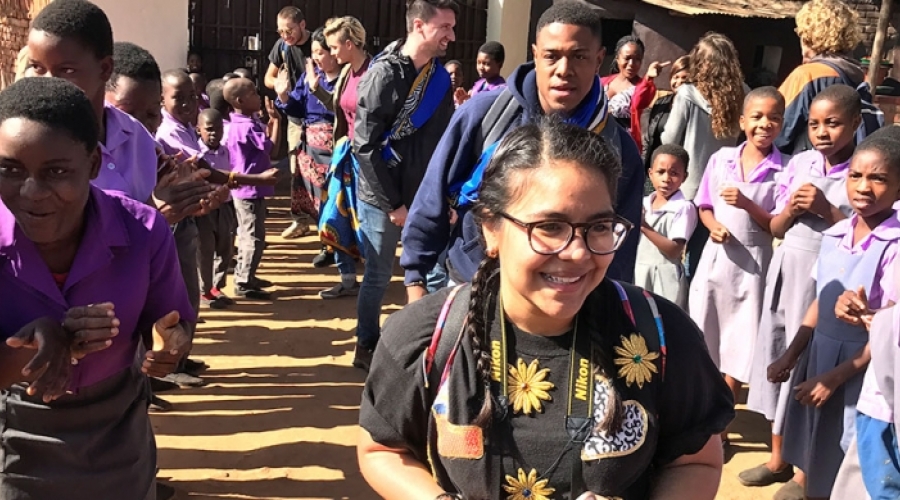
Part One of Our Story on Creative Action's Partnership with Jacaranda School for Orphans
As their bus pulled up to the Jacaranda School for Orphans in Limbe, Malawi, eight Otis College of Art undergraduates felt anxious. None had travelled to Africa before, nor knew what to expect at this school for the continent’s poorest, most bereft children. But when Jacaranda’s gates swung open, apprehensions dissolved in a swarm of purple. Forming two lines that stretched across the campus, four hundred uniformed primary and secondary school kids clapped and shouted greetings to the beat of drums. They grabbed the hands of their visitors and drew them into a joyful dance that lasted for twenty minutes. “Their spirit gets to you,“ said Wei, an Otis architecture major, of his exhilaration.
Every day for the next week, Otis teams implemented designs on campus they had developed in a semester-long “Creative Action” course culminating in this trip. They had drawn up problem-solving projects after Skyping with Jacaranda kids to gauge their needs and desires, collected materials and brought them to Malawi. In a makeshift outdoor workshop on a far corner of campus, Wei and Brandon, recruited chess club members to help cast in cement and paint an outdoor chess set of foot-high abstract pieces. Meanwhile Monsy, Sophie and Noah assembled a chessboard out of tiles stenciled with images of African animals, to be embedded into the dirt under a Jacaranda tree.
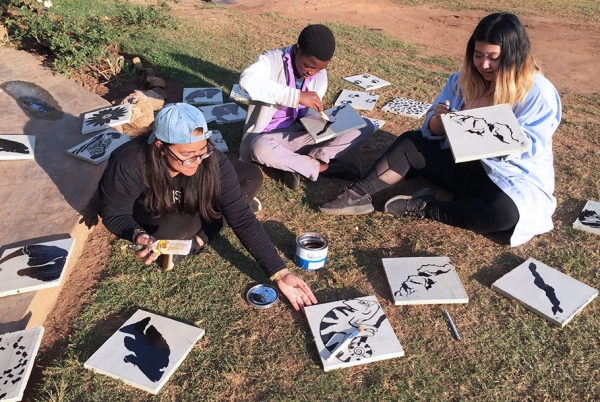
Hives of Otis-sparked creativity broke out in classrooms and the schoolyard. Sophie introduced fashion design in a studio where boys and girls drew, cut and pasted outfits on paper dolls. In a poetry-writing class, Jeff encouraged 8th-graders to express their feelings in haiku. Kim made musical instruments out of found objects including bottles and flip-flops and hung them in the playground. Yasamina drafted a crew to paint a mural next to the basketball court. Noah played Michael Jackson tunes for his group drawing class, and the kids danced and sang along as they scribbled. By week’s end, the children were pressing notes into the palms of their Otis friends. “Please don’t go home,” said one.
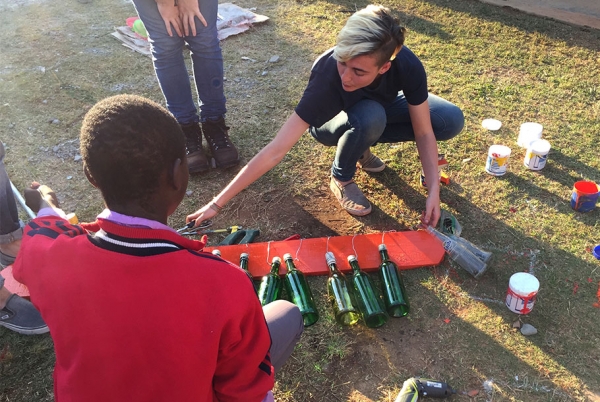
“A Core Value”
The Otis-Jacaranda exchange is a touchstone of the College’s mission: to train artists and designers to apply their creative skills to real-world problems and effect positive change. Otis has long had a reputation for cultivating professional excellence in its diverse student body. Offering BFA degrees in Architecture/Landscape/Interiors, Communication Arts, Digital Media, Fashion Design, Fine Arts, Product Design and Toy Design, Otis pours its graduates into good jobs in California’s thriving creative industries. In its annual college rankings for 2017, Money Magazine ranked Otis #4 on its “50 colleges that add the most value” list.
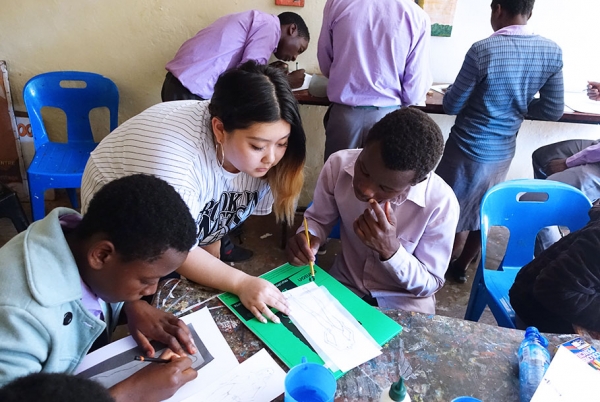
What has been less well known about Otis is its commitment to socially responsible design. Its Creative Action program engages students with local and international communities to study environmental and social issues and devise solutions. Otis is the only major American art college with a compulsory program to cultivate humanistic design strategies. Through its network of non-profit partnerships, Creative Action students have built a sensory bamboo garden at a Los Angeles school for the blind; drafted proposals for decreasing plastic waste in the oceans; travelled to China to help create sustainable toys; teamed up with Palau residents to design and build a WW2 Freedom Memorial commemorating Palauans who served in the U.S. Armed Forces.
“Otis wants all its students to understand both social responsibility and teamwork,” says Creative Action Director Rich Shelton, who conceived and launched the Malawi project. “They get excited about learning that they can make a big difference in the world.” President Bruce Ferguson explains that innovative thinkers who thrive in an interdisciplinary, collaborative environment are essential to the 21st-century workplace. “We see Creative Action as an absolute necessity,” says Ferguson. “That’s why it’s embedded in our curriculum. We don’t have social good off to the side. It’s a core value.”
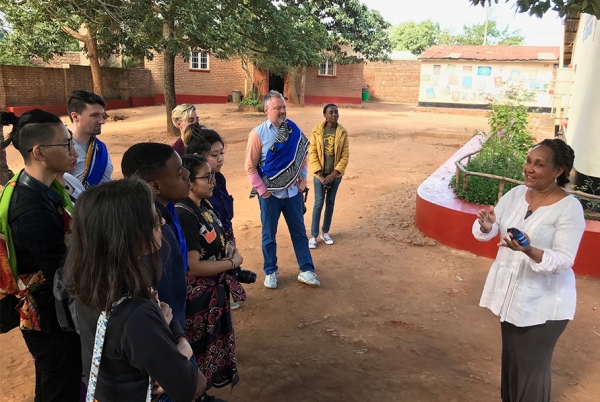
The Partner
Shelton had been introduced via Skype to Jacaranda’s founder, Marie da Silva, and her husband Luc Deschamps, the school’s executive director, by an Otis alumnus. Within minutes, “I knew we were going to Malawi,” says Shelton. Da Silva had opened the school in her home village of Che Mbowa in 2002 after losing 15 relatives, including her father and two brothers, to AIDS. With limited health services as one of the poorest African countries, Malawi was being decimated by the HIV epidemic. (Since then a public education campaign and improved medical care has helped stabilize the infection rate.)
Working in Los Angeles as a nanny, Da Silva felt compelled to do something for the children who lost their parents in Che Mboma, which is located near the city of Limbe in southern Malawi. She and her mother turned their family home into a school for orphans, converting bedrooms and the living room into classrooms. For seven years Da Silva continued her nanny job, sending her wages home to subsidize Jacaranda. Eventually, she moved back to Malawi, partnered with Deschamps, a French former journalist, and was named a CNN hero, which helped the couple raise awareness and money to grow the school.

“These kids want to learn,” says Da Silva. “We give them the tools. And we need help.” Da Silva and Deschamps are dedicated to education as the path to health and prosperity for Malawi. Jacaranda is the only entirely free primary and secondary school for Malawi’s 800,000 orphans. The students are provided with books, daily nutrition and nursing assistance. Screened for HIV, those who test positive are given treatment and medication so they can regain health and attend school.
New classrooms, a science lab, auditorium, and library encircle Da Silva’s former home. The school employs top-notch teachers and has sent 75 graduates to college and two to medical school. Jacaranda enfolds its students in a progressive ambiance that dispels shame and ignorance about HIV. “We are taking away the stigma,” says Da Silva. “We talk about our problems.”
Most students live with grandparents or other relatives who receive financial support from Jacaranda for food. The school provides micro-loans to women in the village to start small businesses and helps with housing construction. “You have to look at where the kids are coming from,” says Da Silva. “If they are abused and starving they can’t learn.” She also fights within the legal system to protect teenage girls, who are vulnerable to sexual assault. “We have put five men in jail for abusing girls,” she says.
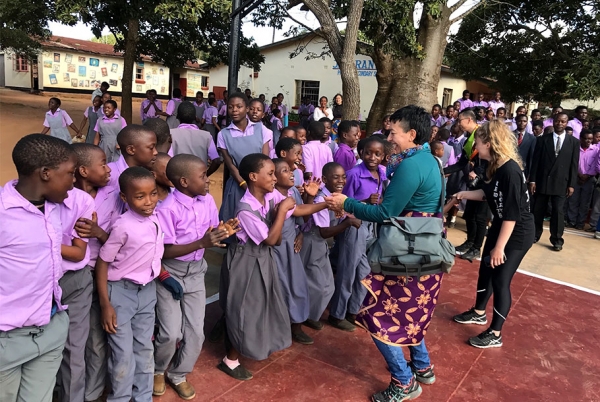
Strong advocates for the healing power of the arts, Da Silva and Deschamps hoped the kids would benefit from the zest and resourcefulness of the Otis eight. “I have all these children who saw their mothers die,” says Da Silva. “And there is no therapy available. I said ‘how about if we give them art?’ It’s important for children to have the arts. It takes away the stress. Let them sing, let them dance and play sports.”
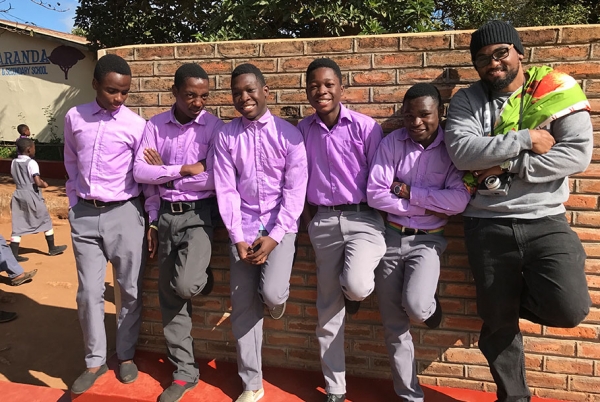
Check out Part Two of this story to learn more about our students' journey to Malawi. A Creative Action group will be traveling to the Jacaranda School this summer to continue this life-changing partnership. Students from Otis College and the Jacaranda Foundation will be hosting a live auction of their artwork on Sunday, April 22. All proceeds will support Otis and Jacaranda student expenses for upcoming trips. Learn more.
Related News


Otis Design Lab Offers Real-World Experience to Otis College Students
December 08, 2023
